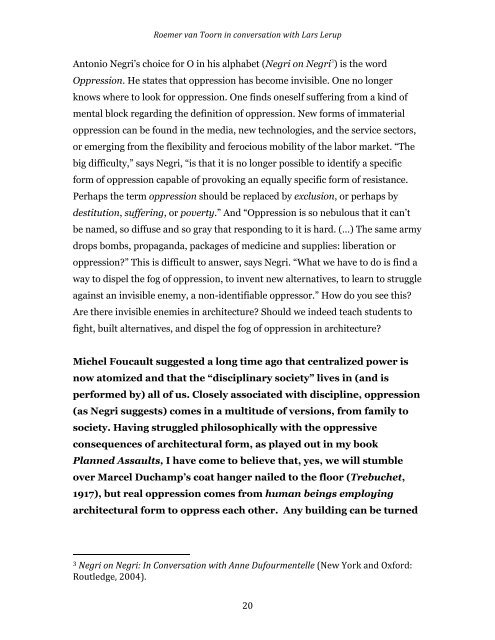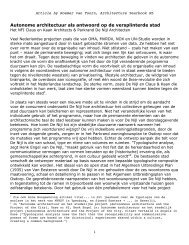ABCD Lars & Roemer
ABCD Lars & Roemer
ABCD Lars & Roemer
Create successful ePaper yourself
Turn your PDF publications into a flip-book with our unique Google optimized e-Paper software.
<strong>Roemer</strong> van Toorn in conversation with <strong>Lars</strong> Lerup <br />
Antonio Negri’s choice for O in his alphabet (Negri on Negri 3 ) is the word<br />
Oppression. He states that oppression has become invisible. One no longer<br />
knows where to look for oppression. One finds oneself suffering from a kind of<br />
mental block regarding the definition of oppression. New forms of immaterial<br />
oppression can be found in the media, new technologies, and the service sectors,<br />
or emerging from the flexibility and ferocious mobility of the labor market. “The<br />
big difficulty,” says Negri, “is that it is no longer possible to identify a specific<br />
form of oppression capable of provoking an equally specific form of resistance.<br />
Perhaps the term oppression should be replaced by exclusion, or perhaps by<br />
destitution, suffering, or poverty.” And “Oppression is so nebulous that it can’t<br />
be named, so diffuse and so gray that responding to it is hard. (…) The same army<br />
drops bombs, propaganda, packages of medicine and supplies: liberation or<br />
oppression?” This is difficult to answer, says Negri. “What we have to do is find a<br />
way to dispel the fog of oppression, to invent new alternatives, to learn to struggle<br />
against an invisible enemy, a non-identifiable oppressor.” How do you see this?<br />
Are there invisible enemies in architecture? Should we indeed teach students to<br />
fight, built alternatives, and dispel the fog of oppression in architecture?<br />
Michel Foucault suggested a long time ago that centralized power is<br />
now atomized and that the “disciplinary society” lives in (and is<br />
performed by) all of us. Closely associated with discipline, oppression<br />
(as Negri suggests) comes in a multitude of versions, from family to<br />
society. Having struggled philosophically with the oppressive<br />
consequences of architectural form, as played out in my book<br />
Planned Assaults, I have come to believe that, yes, we will stumble<br />
over Marcel Duchamp’s coat hanger nailed to the floor (Trebuchet,<br />
1917), but real oppression comes from human beings employing<br />
architectural form to oppress each other. Any building can be turned<br />
<br />
3 Negri on Negri: In Conversation with Anne Dufourmentelle (New York and Oxford: <br />
Routledge, 2004). <br />
20






